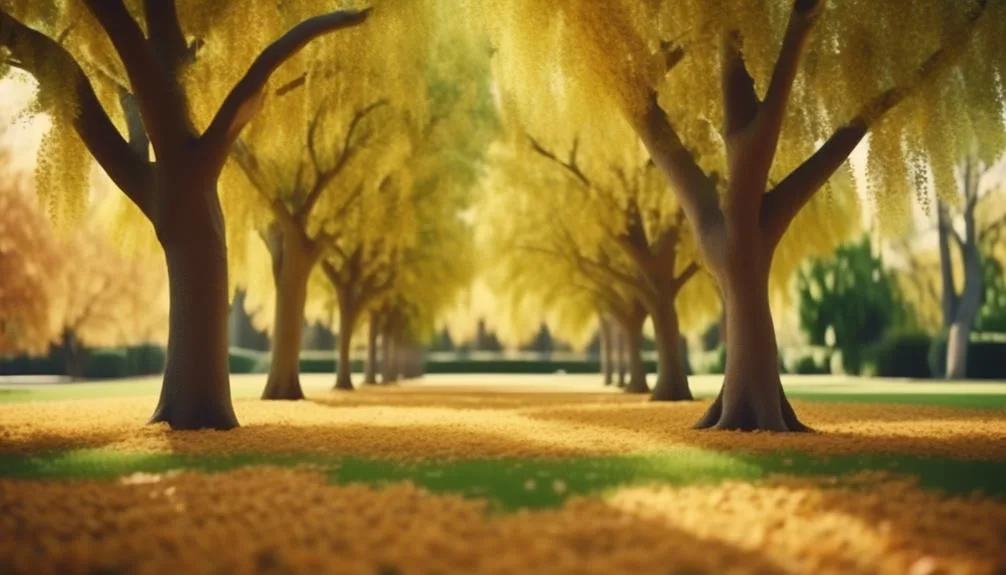Choosing the right elm tree for your landscape is a decision that requires careful consideration. Factors like the type of elm, climate, and soil conditions in your area are important to think about.
By understanding these key considerations, you can make sure the elm tree you choose not only looks good in your outdoor space but also thrives in its new home.
Elm Tree Varieties: Identifying Options
When choosing an elm tree for your landscape, it's essential to identify the various options available to ensure the perfect fit for your needs. Elm tree identification is crucial as there are many varieties, each with its own unique characteristics. Look for the American Elm with its classic vase shape and rich green foliage, or the Lacebark Elm known for its mottled bark and resistance to Dutch elm disease.
Proper planting techniques are also vital for the tree's health and longevity. When planting your elm, ensure the hole is twice as wide as the root ball, but no deeper. Gently loosen any encircling roots to encourage outward growth. Remember to water deeply after planting and add a layer of mulch to help retain moisture and suppress weeds.
Considerations for Landscape Suitability
To ensure the perfect fit for your landscape, it's crucial to consider the suitability of different elm tree varieties, each with its own unique characteristics, for your specific needs.
When considering tree placement, think about the size of the mature tree and its proximity to structures, power lines, and other trees. Some elm varieties are better suited for compact spaces, while others thrive in open areas.
Additionally, take into account the aesthetic appeal you desire for your landscape. Certain elm tree varieties offer stunning fall foliage, while others have distinctive bark patterns that add visual interest year-round.
Climate and Soil Requirements
Selecting the right elm tree for your landscape requires a keen understanding of the specific climate and soil requirements that each variety demands. Elm trees generally thrive in well-drained soil with a slightly acidic to neutral pH level. They also prefer full sun or partial shade, depending on the specific variety.
When planting an elm tree, it's crucial to consider the overall climate of your region. Some elm varieties are more tolerant of cold temperatures, while others are better suited to warmer climates.
Additionally, it's important to be aware of elm tree pests, such as the destructive Dutch Elm Disease, and implement appropriate tree planting techniques to minimize the risk of infestation.
Size and Growth Characteristics
Considering the climate and soil requirements we discussed, it's essential to understand the size and growth characteristics of different elm tree varieties to ensure the perfect fit for your landscape.
- Mature Height: Some elm trees can reach towering heights of 80 feet or more, while others stay more compact at around 30 feet, so consider the available space in your landscape.
- Growth Rate: Certain elm trees grow rapidly, providing quick shade and beauty, while others have a slower, steadier growth, offering a more manageable option.
- Spread: Be mindful of the tree's canopy spread to ensure it won't encroach on nearby structures or other plants.
- Pruning Techniques: Understand the specific pruning needs of the elm tree variety you choose to maintain its health and appearance.
Understanding these size and growth characteristics, along with implementing proper tree care essentials, will help you select an elm tree that thrives in your landscape.
Maintenance and Disease Resistance
When caring for an elm tree in your landscape, it's crucial to understand the necessary maintenance and the tree's resistance to common diseases. Proper pruning techniques are essential for maintaining the health and shape of your elm tree. Regular pruning helps remove dead or diseased branches, improving air circulation and reducing the risk of disease.
Additionally, it's important to follow a fertilization schedule to ensure the tree receives the necessary nutrients for healthy growth. Elm trees generally have moderate water needs, but it's important to monitor soil moisture and adjust watering accordingly.
When it comes to pest control, keeping an eye out for common pests such as elm leaf beetles and aphids is crucial. By incorporating these maintenance practices, you can help your elm tree stay healthy and resilient against common diseases.
Conclusion
In choosing the right elm tree for your landscape, consider climate, soil, size, and maintenance needs to ensure long-term health.
Making an informed decision now will lead to a thriving and disease-resistant tree in the future.
Happy tree planting!

My interest in trees started when I first saw the giant sequoias in Yosemite.
I was a teenager then, and I remember thinking, “I need to learn more about this.”
That moment stuck with me.
A few years later, I went on to study forestry at Michigan Tech.
Since graduating, I’ve worked in a mix of hands-on tree care and community education.
I’ve spent over ten years helping people understand how to plant, maintain, and protect the trees in their neighborhoods.
I don’t see trees as just part of the landscape.
They are living things that make a real difference in our daily lives.
